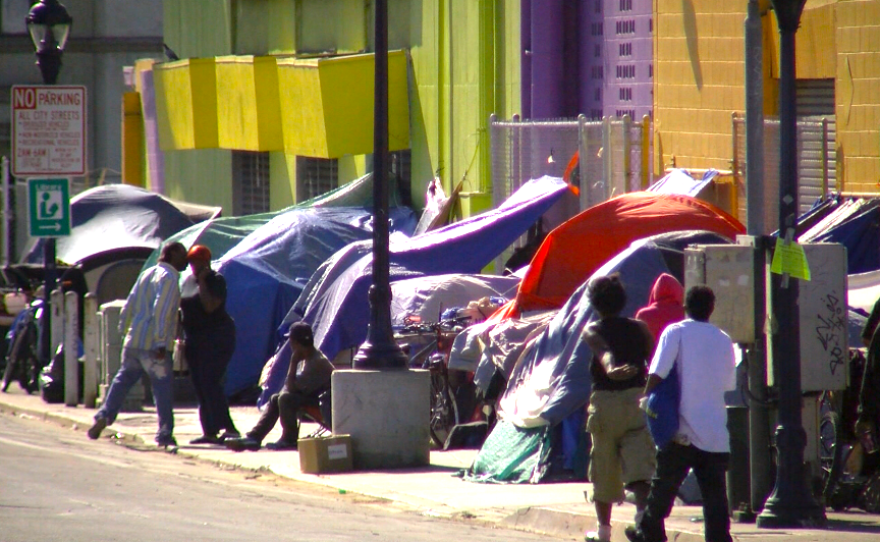As San Diego leaders scramble in boardrooms and high-rise offices to combat one of the worst homeless problems in the nation, social workers are on the front lines of the crisis, already putting plans into action.
“I know I’m here for a purpose and that is to help one homeless person at a time,” said Agnes Cole, a caseworker with Father Joe’s Villages, the region’s largest shelter and homeless service provider. The nonprofit is located on the edge of downtown in the East Village, also known as ground zero of homelessness.
San Diego County has seen a significant rise in its homeless population. The number of people sleeping outside in tents and under overpasses has soared 40 percent over the last three years.
RELATED: San Diego Housing Homeless To Change Lives, Tent-Covered Landscapes
Cole’s job is to help people get off the streets and into permanent supportive housing. The subsidized living spaces are usually a single room, a converted motel unit or a studio apartment, with onsite counseling and other services.
“It breaks my heart every day when I walk the streets looking for people in tents,” said Cole, whose social work career has spanned more than a decade. “For me, when it comes to helping people I take it personally.”
It is not an easy job, Cole said, because often people who need the most help refuse assistance.
“After going through so many programs — most of them didn’t work out,” she explained. “When I approach them I know they don’t believe me when I say, ‘I’m going to get you into housing for the rest of your life.’”
For those Cole does reach, she walks them through an application process and finds a landlord who will accept them, even despite issues such as evictions, bad credit, or a prior criminal offense.
“And sometimes you want to give up on the person, but is that the solution? No. It’s not a solution,” she said. “You still have to keep pushing.”

While waiting for a housing unit, she assesses their needs, helps them get an ID and a social security card if they need them, and looks for other funding programs they might qualify for, including food stamps and disability.
“It’s working,” Cole said. “But you have to be patient. You have to understand where they’re coming from.”
For many homeless, they are coming from years of sleeping on floors and cement, lugging all their belongings in a cart, eating in soup kitchens and struggling with disabilities and despair.
RELATED: Advocate Wages Social Media Campaign Against San Diego’s Homeless Enforcement
“And that’s why I go looking for my clients tent to tent,” Cole said.
The mother of three compares the conditions on the streets of downtown to the war zone she fled 13 years ago in West Africa.
“Trust me, I understand it,” she said. “I know what it is. And when I look at these people in the streets it breaks my heart.”
Nearly 1,300 people sleep along the outskirts of the East Village, where a hub of charities serves the homeless. Stretches of sidewalks are covered in encampments and trash; public restrooms include just a handful of toilets. Some say the conditions are a contributor to the recent Hepatitis A outbreak.
“It’s almost like there’s two societies when I see all that I see every day,” said Colleen Gruber, who is also a caseworker with Father Joe’s Villages. “We as a society have forgotten what’s worthy and what is of value, and that’s us as human beings, and caring for one another.”

Two decades ago, Gruber also journeyed through homelessness, hitch-hiking across Europe while hooked on opium.
“That is a monster that I’m very familiar with, and so for 27 years I lived like that,” Gruber said. “But there was this little light in my heart that was very dim and I did my best to put it out but that didn’t happen.”
Gruber got clean, went to college for a degree in social work and now spends every day looking for a dim hope in others.
“I tell them, 'If you don’t believe in yourself, believe that I believe that you can change,'” Gruber said. “Your life can change.”
RELATED: People Sleeping On Streets In San Diego County Increases 14 Percent
San Diego has a new three-year initiative to get at least 3,000 people off the streets and into permanent supportive housing. Rick Gentry, CEO of the San Diego Housing Commission, is one of the leaders overseeing the $80 million project. The Housing Commission, which provides affordable housing opportunities for low-income individuals and families, added homelessness programs to its mission three years ago.
“What San Diego’s got to do is understand the transition from a small city to a true urban area,” said Gentry. "With a housing expansion, instead of being pushed out, pushed in and up. And greater density, which could also provide more affordability.”
Gentry said the waiting list for an affordable housing voucher is currently seven to 10 years.
“We’ve got 75,000 applicants versus 15,000 occupied units with a turnover rate of about 100 a month. You can do the math,” Gentry said.
Homeless people are one of the populations receiving priority right now, as well as disabled, elderly and veterans. Turning the homeless and housing crisis around will require more places for people to live and more funding to build it, Gentry said.
"Things are already turning around. It’s just a matter of where you look and what you expect to see," Gentry said. “The thing I don’t know how to predict is what the growth and problems are going to continue to be, despite all the efforts and attention that we’re giving to it,” he said.
For Agnes Cole, looking out onto the streets and seeing all the people in need is overwhelming. That is why she has her own strategy.
“It’s possible to help," Cole said. "But one person at a time. One person at a time."






